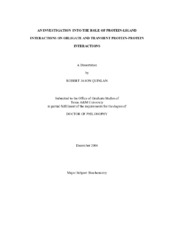| dc.contributor.advisor | Reinhart, Gregory D. | |
| dc.creator | Quinlan, Robert Jason | |
| dc.date.accessioned | 2005-02-17T21:01:18Z | |
| dc.date.available | 2005-02-17T21:01:18Z | |
| dc.date.created | 2004-12 | |
| dc.date.issued | 2005-02-17 | |
| dc.identifier.uri | https://hdl.handle.net/1969.1/1430 | |
| dc.description.abstract | Protein-ligand and protein-protein interactions are critical to cellular function. Most cellular metabolic and signal tranduction pathways are influenced by these interactions, consequently molecular level understanding of these associations is an important area of biochemical research. We have examined the thermodynamics of several protein-protein associations and the protein-ligand interactions that mediate them.
Using Fluorescence Correlation Spectroscopy, we have examined the putative interaction between pig heart malate dehydrogenase (MDH) and citrate synthase (CTS). We demonstrate a specific, low-affinity interaction between these enzymes. The association is highly polyethylene glycol (PEG)-dependent, and at high concentrations of NaCl or PEG, non-specific aggregates are formed. We demonstrate that oxaloacetate, the intermediate common to both CTS and MDH, induces the association at concentrations below the Km of CTS, suggesting that the open conformation of CTS is involved in the association.
Using several biophysical techniques, we have examined the subunit associations of B. stearothermophilus phosphofructokinase (PFK). We demonstrate that the inhibitor bound conformation of the enzyme has reduced subunit affinity. The kinetics and thermodynamics of the phosphoenolpyrvuate (PEP)-induced dissociation of PFK have been quantified. Binding substrate, fructose-6-phosphate (F6P), stabilizes the enzyme to inhibitor-induced dissociation by 132-fold. These data suggest that subunit associations may play a role in the allosteric inhibition of PFK by PEP.
The thermodynamics of the protein-ligand associations and allosteric inhibition of E. coli phosphofructokinase have been examined using intrinsic fluorescence and hydrostatic pressure. Both ligand-binding affinity and PEP inhibition are diminished by pressure, whereas substrate-binding affinity for inhibitor-bound enzyme is pressure-insensitive. Larger entropic than enthalpic changes with pressure lead to the overall reduction in free energies.
Using a fluorescence-based assay, we have developed a series of baroresistant buffer mixtures. By combining a buffer with acid dissociation of negative volume with a buffer of positive volume, a pressure-resistant mixture is produced. Alteration of the molar ratio of the two component buffers yields mixtures that are pressure-insensitive at pH values around neutrality. | en |
| dc.format.extent | 6783102 bytes | en |
| dc.format.medium | electronic | en |
| dc.format.mimetype | application/pdf | |
| dc.language.iso | en_US | |
| dc.publisher | Texas A&M University | |
| dc.subject | protein-protein interactions | en |
| dc.subject | protein-ligand interactions | en |
| dc.subject | hydrostatic pressure | en |
| dc.subject | allosteric regulation | en |
| dc.title | An investigation into the role of protein-ligand interactions on obligate and transient protein-protein interactions | en |
| dc.type | Book | en |
| dc.type | Thesis | en |
| thesis.degree.department | Biochemistry and Biophysics | en |
| thesis.degree.discipline | Biochemistry | en |
| thesis.degree.grantor | Texas A&M University | en |
| thesis.degree.name | Doctor of Philosophy | en |
| thesis.degree.level | Doctoral | en |
| dc.contributor.committeeMember | Johnson, Arthur E. | |
| dc.contributor.committeeMember | Hu, James C. | |
| dc.contributor.committeeMember | Cremer, Paul S. | |
| dc.type.genre | Electronic Dissertation | en |
| dc.type.material | text | en |
| dc.format.digitalOrigin | born digital | en |


